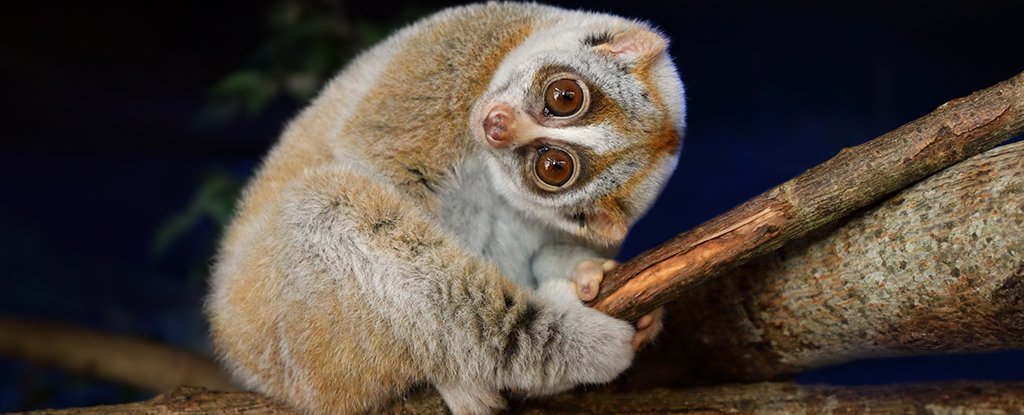为什么人类对猫过敏
世界上唯一有毒的灵长类动物可以解释:为什么人类对猫过敏
For those with a severe cat allergy, any location that harbours a pet feline can become a toxic no-go zone. Research on another tragically cute mammal now suggests this might be no accident of nature – cats really are trying to keep us away.
对于那些对猫有严重过敏反应的人来说,任何养猫的地方都可能成为有毒的禁区。对另一种可悲可爱的哺乳动物的研究表明,这可能不是自然的意外——猫真的试图把我们赶走。
A study on the world's only known example of a venomous primate has found a surprising similarity between a key protein in its armpit glands and the allergen found in cats, raising the suggestion that if one evolved as a defensive weapon, so might the other.
一项对世界上唯一已知的有毒灵长类动物的研究发现,在其腋窝腺的一种关键蛋白质与猫身上发现的过敏原之间存在惊人的相似性,这提出了一个假设,即如果一种动物进化为防御性武器,那么另一种动物也可能进化为防御性武器。
It's a finding that not only puts cat allergies into a new context, but could lead to treatments for those suffering the effects of an unpleasant encounter with either animal.
这一发现不仅将猫过敏纳入了一个新的范畴,而且还可能为那些遭受与任何一种动物的不愉快遭遇的人带来治疗。

Slow lorises (Nycticebus sp.) are several species of primate commonly found in the wilds of South and Southeast Asia. Looking at one, you'd swear it was dreamed up in a Hasbro toy workshop for toddlers.
慢懒猴(Nycticebus sp.)是在南亚和东南亚的野外常见的几种灵长类动物。看着它,你会发誓它是孩之宝(Hasbro)为幼儿设计的玩具车间里凭空想出来的。
But don't let the looks fool you. Inside the loris's mouth are rows of tiny, razor-sharp teeth used to both tear into small prey and keep predators and competitors at bay.
但不要让外表蒙蔽了你。在懒猴的嘴巴里有一排排锋利的小牙齿,用来撕咬小猎物,防止捕食者和竞争者靠近。
As if a bite isn't enough, when threatened, the fluff monsters put their hands up and lick the glands tucked away in their armpits, dosing their spit with a rich array of compounds fine-tuned to help transform a tiny cut into a festering hole of dead flesh.
好像被咬了还不够似的,当受到威胁时,这些毛茸茸的怪物会举起手来舔腋窝里的腺体,往他们的唾液里加入丰富的化合物,这些化合物经过精心调整,可以帮助把一个小伤口变成一个化脓的死肉洞。
"Generally slow lorises use their venom to fight with other slow lorises, causing very slow-to-heal wounds," says biologist Bryan Fry from the University of Queensland in Australia.
澳大利亚昆士兰大学的生物学家布莱恩·弗莱说:“通常情况下,慢懒猴会用它们的毒液与其他慢懒猴打斗,导致伤口愈合非常缓慢。”
"But, when humans are bitten, the victim will display symptoms as if they're going into allergic shock."
“但是,当人类被咬伤时,受害者会表现出过敏休克的症状。”
Those symptoms can include difficulty breathing, blood in the urine, extreme pain, and - in the worst cases - anaphylactic shock.
这些症状包括呼吸困难、尿中带血、极度疼痛,在最严重的情况下还会出现过敏性休克。
The secretions responsible for the toxic effects of the animal's bite are known to include more than two hundred aromatic compounds, many of which have already been characterised.
已知负责动物咬伤毒性作用的分泌物包括超过二百种芳香化合物,其中许多已经被鉴定过。
But among them are a bunch of proteins which still pose some mystery, and it's these chemicals that Fry and his team sequenced to learn more about their origins and toxicity.
但其中有一堆蛋白质仍然有些神秘,弗莱和他的团队对这些化学物质进行排序,以了解它们的来源和毒性。
Surprisingly, the proteins weren't entirely new to science. In fact, many of us are painfully familiar with them already.
令人惊讶的是,这些蛋白质在科学上并不完全是新的。事实上,我们中的许多人已经痛苦地熟悉了它们。
This research was published in Toxins.
这项研究发表在《毒素》杂志上。


















